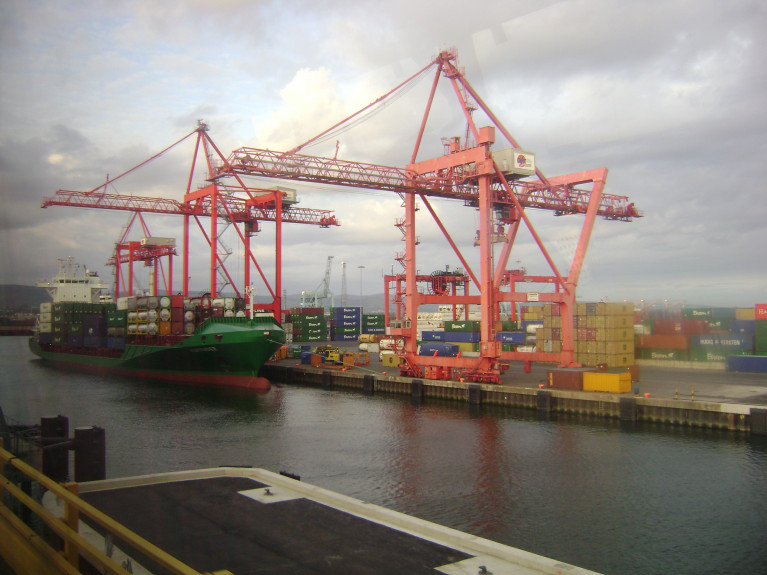Displaying items by tag: HeavyLift vessel
Chinese Heavy-Lift Ship With Straddle-Carriers from Africa Calls to Dublin Port Container Terminal
Afloat tracked a Chinese heavy-lift vessel loaded with a project cargo of straddle-carriers which sailed from Oran, Algeria in north Africa and arrived in Dublin Port this morning, writes Jehan Ashmore.
The four straddle-carriers (container carrying vehicles) on board the general cargo / heavy-lift vessel Da Ji (2016/21,922grt) which is operated by the Chinese state-owned Cosco Shipping Speciliazed Carriers, had taken almost 5 days to complete the voyage.
Cosco was formerly known as the Guangzhou Ocean Shipping Co Ltd established in 1961 is the first state-owned ocean shipping enterprize of new China and is a historical breakthrough in developing China's ocean shipping business.
On arrival of Da Ji, the heavy-lift vessel was met by a pair of tugs within the port's fairway and close to the entrance. The tug Beaufort operated by Dublin Port Company led Da Ji by the bow while Giano took a position astern of the heavy-lift carrier. Afloat has identified the latter tug to be run by the Dublin 7 based Purple Water Towing Ltd.
Together they assisted the near 180m vessel alongside one of Irish Continental Group's (ICG) container divisions, Dublin Ferryport Terminals (DFT) which took place before 10 o'clock this morning. Afloat awaits a response from ICG with information on the straddle-carriers cranes.
Subject to weather conditions today they will be unloaded at the 32 acre terminal which is held on a leasehold basis. It is not known if the straddle-carriers were loaded in north Africa or previously loaded elsewhere. As for the remaining pair of the part-cargo which is to be discharged at another port, perhaps Belfast?
DFT's terminal (located close to the Terminal 1 and used by ICG's Irish Ferries) is currently equipped with Liebherr ship-to-shore (STS) container gantry cranes (40 tonne capacity) and 10 rubber tyred gantries (40 tonne capacity).
A counterpart of the Dublin operation is ICG's Belfast Container Terminal which is the sole such terminal at Belfast Harbour which is under a services concession agreement with Belfast Harbour Commissioners (BHC). This 27 acre site is equipped with 3 STS gantry cranes, 3 rail mounted gantry cranes and 3 straddle carriers.
Da Ji is designed to carry large project cargoes asides container gantry cranes, barges and also transportation of containers.
On a related note, ICG's other container division, Eucon Shipping & Transport has one of their seven chartered load-on load off (Lo-Lo) vessels the 139m Elbecarrier also berthed at the DFT terminal. Unlike the heavy-lift vessel, the container ship was berthed on the port channel side of the facility that overall has quay length of 480m, enabling in total three vessels to berth.
The 974TEU capacity vessel operates as part of Eucon's network of routes connecting also Belfast and Cork with the mainland continental European ports of Rotterdam, Antwerp (and other ports on incentive). Noting that these hub ports are connected with road, rail and inland waterway networks penetrating into central Europe.
In order to operate these Eucon 'feeder' services that also link in with deep-sea global carriers, they deploy 3,800 owned and leased containers which is the equivalent to 7,400TEU. They include various types among them reefers i.e. refrigated containers.
On occasions large accumulations of 'empty' containerships have been loaded especially to be taken away by ship. In recent years such a development took place albeit at another leased terminal within Dublin Port's estate.




























































